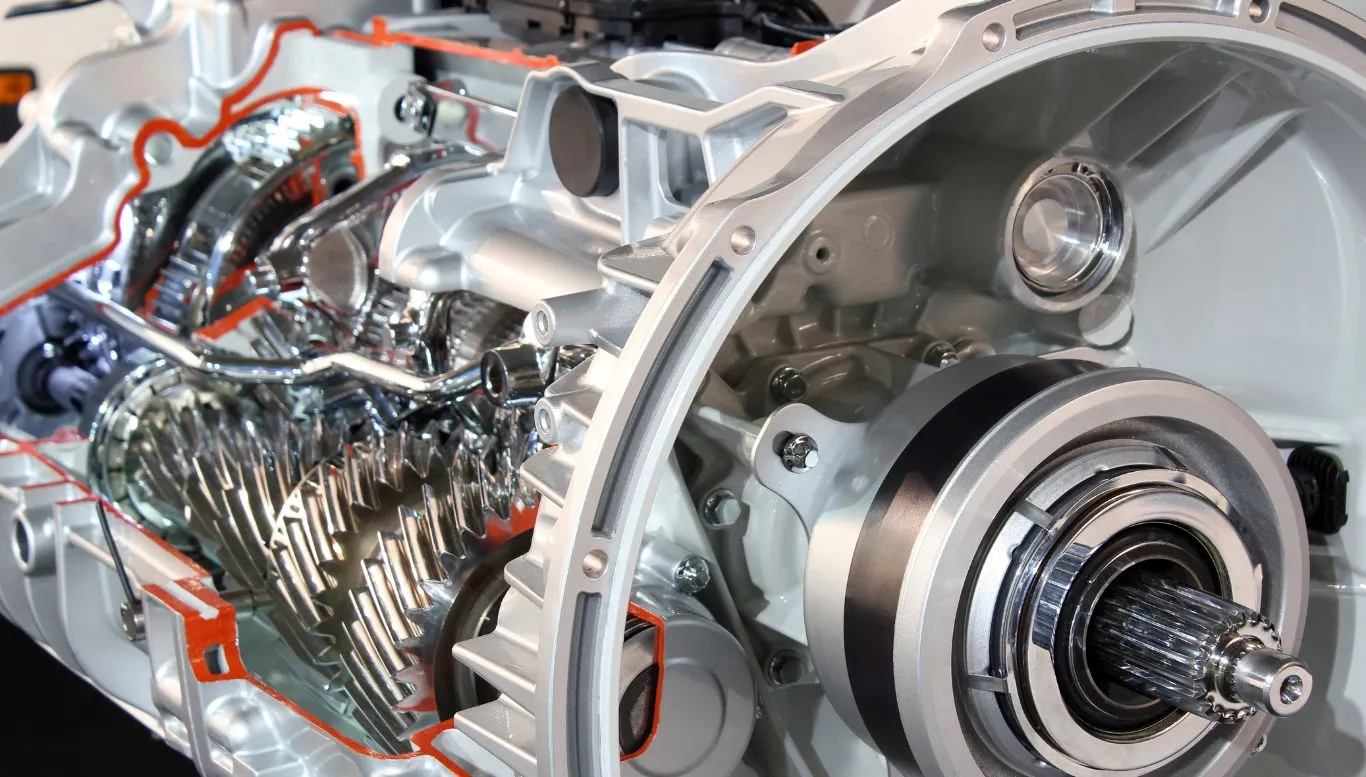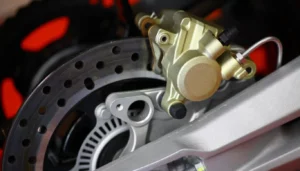If you’re an avid motorcyclist, you’re undoubtedly familiar with the sheer joy that riding brings. However, just as with any machine, motorcycles aren’t immune to mechanical problems. Transmission issues, in particular, can cause significant disruption in your riding experience. This article is set to guide you through common motorcycle transmission issues along with their recommended fixes.
Perhaps you’ve noticed an unfamiliar sound, an unexpected gear shift, or an uncharacteristic loss of power. These could all signal that your motorcycle is battling a transmission problem. Fear not, for below, you will find a comprehensive guide detailing regular transmission issues and the corrective actions you can take. Strap your helmet on; we’re about to make that bumpy ride a whole lot smoother.
Motorcycle Transmissions
Understanding the intricacies of a motorcycle’s transmission system can be a challenging task for any motorbike enthusiast. The transmission plays a crucial role in the operation of a motorcycle. However, like any mechanical system, issues can develop over time. In this article, we’ll explore some common transmission issues that plague motorcycles, and lay out some straightforward solutions to help get you back on the open road in no time.
Slipping Gears
A frequently encountered transmission issue with motorcycles involves gears that slip. When this happens, your bike may spontaneously switch gears without any input from you. This can be dangerous, especially when riding at top speeds. Generally, it’s caused by worn-out internal components inside the gearbox due to poor maintenance or age. To rectify this issue, it’s usually necessary to replace the worn parts; a job best left to experienced mechanics. Regular gearbox maintenance, including changing the oil and constant monitoring, can prevent this issue.
Difficulty Shifting Gears
Another common transmission problem experienced by bikers is trouble shifting gears. This issue can manifest as a bike getting “stuck” in a particular gear, or difficulty maneuvering the gear shift lever. This can be as a result of a misaligned gear shift lever, a degraded clutch, or damaged internal transmission gears. A proper fix for this issue varies based on the cause; it might involve readjusting the gear shift lever or replacing the affected parts. Professional help is highly recommended in such instances. Regular check-ups can also go a long way in preventing these complications.
Clutch Drag
Clutch drag is that unfortunate circumstance when your bike does not fully disengage from the engine, even when the clutch lever is pulled in. This can lead to difficulty shifting gears or even a stalled engine. Generally, clutch drag may be due to an improperly adjusted clutch cable, a worn-out clutch plate, or lubrication issues within the clutch system. To resolve this, you might need to adjust your clutch cable, switch your lubricant, or replace your clutch plate, depending on the root cause. Professionals should handle serious clutch drag situations, but preventing the problem can be as simple as regular clutch maintenance.
Signs of Transmission Problems in Motorcycles
Let’s delve into the nitty-gritty of motorcycle transmissions and decode the signs of typical problems. Regardless of whether you’re a novice rider or a seasoned biker, recognizing these issues early can save you from substantial repair bills down the line.
Excessive Noise
One telltale sign of transmission trouble in your motorcycle is excessive noise. If you’re hearing grinding sounds every time you shift gears, it’s time to take notice. These unpleasant noises can stem from faulty gears. Remember, motorcycles are supposed to purr, not growl.
Frequent Neutral Hits
It’s normal to occasionally hit neutral when attempting to shift between first and second gear. However, experiencing this frequently may be indicative of a transmission issue. You may need to adjust your motorcycle’s gear lever or get the clutch inspected for wear and tear.
Stalling at Stop Signs
If your motorcycle stalls every time you stop, it could indicate a transmission problem. Stalling can disrupt your ride and create unsafe situations, especially in traffic. A thorough examination of your motorcycle by a professional mechanic is warranted.
Leaking Transmission Fluid
A visible sign of transmission trouble is leaking fluid. If you spot any unusual drips underneath your motorcycle, be sure to check it out. Leaking transmission fluid is typically a maroonish color. This could be due to a worn-out seal or crack in the transmission casing.
Poor Fuel Efficiency
Last but not least, a drastic drop in fuel efficiency could point towards potential transmission difficulties. If your motorcycle is consuming more gas than usual, it’s a clear sign that something is amiss. Worn-out transmission parts causing friction can lead to this issue.
To summarize, staying alert to these signs can help you diagnose transmission problems in their early stages. Always remember, routine maintenance and corrective action can prolong the life of your motorcycle’s transmission and ensure a smoother ride.
Diagnosing Common Motorcycle Transmission Issues
When it comes to motorcycles, we often pat attention to the engine performance, forgetting that a hardworking transmission plays a critical role in power delivery. Encountering a transmission problem can lead to a rather frustrating experience. However, detecting and addressing these issues early can save you a lot of time, money, and stress. Understanding the nuances of common transmission problems is key in ensuring a smooth ride.
Unusual Grinding or Whining Sounds
Hearing strange noises while shifting gears is not a good sign. It might indicate a worn-out gear or bearings. At times, it could be due to insufficient transmission fluid. Always remember to ensure your motorcycle has an appropriate amount of transmission fluid to prevent premature wearing of gears.
Shaky Transmission
Does your bike feel shaky particularly when shifting gears? It may signify a transmission problem. This may arise from worn out gears, weak clutch springs or even bent shift forks. An experienced mechanic can accurately diagnose and rectify this issue.
Stuck in Gear
Is your bike refusing to shift out of a certain gear? Getting stuck in one gear is a serious transmission problem and extremely dangerous, especially when riding. This issue can result from faulty shifter mechanisms or bent shift forks. A thorough inspection by a qualified mechanic is highly recommended in this case.
Leaking Transmission Fluid
Keep an eye for any signs of fluid leakage, especially a reddish-coloured fluid. This indicates that your motorcycle’s transmission fluid is leaking which can lead to serious damage over time. Regularly check underneath your bike for any visible leaks and ensure seals and gaskets are in good condition.
Noticeable Delay in Gear Engagement
If you notice a considerable delay in gear engagement, that is, your bike doesn’t respond as quickly as it should when shifting gears, there could be a problem with the clutch. In some cases, it might also be an indication of worn-out gears. A prompt check and repair is important to avoid further transmission damage.
Gear Slippage: Causes and Solutions
issues is crucial in maintaining optimum performance. This means diagnosing common problems like gear slippage and knowing how to address them. In motorcycles, one common predicament is premature gear shifting or gear slippage, when your bike suddenly moves from a higher to lower gear without the rider’s initiation.
Causes of Gear Slippage
Multiple factors can lead to gear slippage, and it’s essential for you to familiarize yourself with these triggers.
Worn Clutch Plates
Old or overused clutch plates can no longer grip the clutch disc adequately, making it hard for the gears to hold, hence slipping may occur. Immediate replacement is necessary to revert the situation.
Improper Clutch Adjustment
If your clutch is poorly adjusted, it may not completely disengage, causing the motorcycle to switch gears abruptly. In such instances, adjusting the clutch correctly can help.
Oil Contamination
Clutch plates that are saturated with oil often lead to gear slippage. This is mainly due to oil leaks or a overfilled lubricant tank. The solution is to switch to an oil type suitable for your motorcycle and check oil levels regularly.
Solutions for Gear Slippage
If you’re dealing with gear slippage, fear not. There are effective remedies you can explore.
Clutch Plate Replacement
If your clutch plates are worn or damaged, replacing them with new ones can be a highly effective solution. This process may require a mechanic’s aid if you’re not familiar with the bike’s transmission mechanics.
Proper Clutch Adjustment
A poorly adjusted clutch can lead to gear slippage. By ensuring that the clutch correctly disengages and engages, you can prevent this issue. If you’re unsure about how to adjust the clutch, considering seeking professional help.
Regular Maintenance
Including regular transmission maintenance in your routine checks can help nip any transmission issue in the bud. This involves regularly checking oil levels, maintaining the clutch, and ensuring the gears are in good shape.
Clutch Troubles: How to Identify and Fix
Your motorcycle is a complex machine, and its clutch plays a key role in ensuring that power transfer from the engine to the gearbox runs smoothly. However, like any other part, it can run into problems. Let’s take a closer look at some common clutch troubles and how to go about resolving them.
What’s Going Wrong: Identifying Clutch Troubles
Several signs can indicate a problem with your clutch, and understanding them is the first step towards fixing the issue.
Clutch Slips During Acceleration
This typically indicates a worn-out clutch. It’s a common issue where the clutch fails to disengage even when you’ve released it, causing a noticeable reduction in your bike’s speed even as the engine revs up.
Hard Clutch Lever
If your clutch lever is harder to pull than usual, it may suggest problems with the clutch cable. A frayed or stretched cable, or built-up grime within the cable sleeve, could be the culprit.
Gear Doesn’t Engage Properly
If you notice that your gear isn’t properly engaging when you release the clutch, this can be an indication of a misadjusted clutch.
Fixing It Up: Resolving Clutch Troubles
Now that we’ve identified the potential problems, here’s how you could go about resolving them.
Replace the Clutch Plates
If your clutch is slipping, you’ll likely need to replace the worn-out clutch plates. This is a job best done by a professional to ensure everything aligns properly.
Replace or Clean the Clutch Cable
If you’re dealing with a hard clutch lever, consider replacing the cable entirely. Alternatively, cleaning the existing cable and applying a lubricant can often improve its function.
Adjust the Clutch
If your gear isn’t engaging properly, it may be time to adjust your clutch. You can turn the clutch cable’s adjuster, near the lever, to increase or decrease the clamp force. Remember, this is a delicate balancing act, and it often helps to have professional guidance.
Hard Shifting: Reasons and Remedies
Experiencing difficulties when trying to shift gears on your motorcycle can be distressing. It not only disrupts your enjoyment of the ride but can also indicate more serious transmission problems. Understanding the reasons behind hard shifting can help you address the issue timely and effectively, possibly saving you from costly repairs down the line.
Understanding the Causes of Hard Shifting
Hard shifting can result from a variety of factors. Here are some of the most common:
Incorrect Clutch Adjustment
If your clutch isn’t adequately adjusted, it may lead to problems when changing gears. The clutch cable should have a small amount of free play to engage and disengage correctly. Too much or too little can result in hard shifting.
Damaged Transmission
A worn or damaged transmission can often lead to difficulty in shifting gears. The issues might range from worn gear teeth to a bent shift fork, all requiring professional treatment.
Insufficient Transmission Fluid
Motorcycle transmissions function smoothly with the help of transmission fluid. If you’re low on fluid, it can affect your bike’s ability to shift gears efficiently. Regularly checking and changing your transmission fluid can help avoid this issue.
Solutions for Hard Shifting
Fortunately, addressing hard shifting issues is often straightforward. Here are some potential solutions:
Clutch Adjustment
Ensuring your clutch is appropriately adjusted can resolve many hard shifting problems. If you’re unsure of how to do this, you may wish to consult your motorcycle’s manual or seek a professional mechanic’s help.
Inspect and Repair Transmission
If your transmission is damaged, professional repair or replacement might be necessary. Look for a reputable motorcycle mechanic to inspect your transmission and offer the best solution.
Maintain Proper Transmission Fluid Levels
To keep your gears shifting smoothly, maintain the right transmission fluid level. Check your fluid regularly, and don’t forget to replace it according to your manufacturer’s recommendations.
Noisy Transmissions: What Could be the Culprit?
If you find that your motorcycle transmission is making excessive or unusual sounds, it could be a critical signal of impending problems. Determining the source of these noises can require a little bit of investigation, but by recognizing the kind of sound and when it occurs, you can potentially diagnose the issue. Knowing the culprits behind different noise scenarios is crucial to address and rectify the problem promptly.
Growling or Grinding Noise
Often, a growling or grinding noise when shifting gears can indicate a worn-out clutch or gear damage. This type of sound usually signifies metal-to-metal contact within the transmission due to a lack of lubrication or a severely worn component. A thorough inspection is required to identify the exact issue, after which parts replacement or fixes can be done. Regular inspection and oil changes can help you avoid such problems.
Squealing or Whining Sounds
A high-pitched squeal or whine can be rather alarming. It usually points to a lack of proper lubrication, causing different parts of the transmission to grind against each other. It’s advisable to promptly check your transmission fluid levels and possibly change the fluid. Ignoring such noises can lead to severe damage to the transmission.
Banging or Knocking Noise
Continuous or frequent banging or knocking sounds could be caused by loose or worn-out parts within the transmission. These could be your gears, shift forks or the clutch. It’s vital to have a mechanic inspect your motorcycle immediately to prevent more catastrophic damage.
Stuck in Gear: How to Get Unstuck
Experiencing a situation where your motorcycle is stuck in gear can be a unnerving, especially if you’re biking out on the open road. More often than not, this issue could be traced back to a mechanical malfunction or possibly due to incorrect operation. Here’s a guide on how to deal with this issue:
Probable Causes
A couple of potential explanations may be responsible for a stuck gear. First, your transmission could be damaged or worn, causing reluctance in shifting gears. Second, error or mishandling while shifting gears might lead to getting stuck.
Damaged or Worn Transmission
Similar to all mechanical gears, motorcycle transmissions undergo substantial wear and tear. Over time, these parts can potentially fail, resulting in your bike getting stuck in a specific gear.
Incorrect Shifting
In case you’re not fully familiar with the correct procedure of shifting gears on your motorcycle, you might stall the transmission. This is a common problem among new riders who are still getting accustomed with the bike’s functionalities.
Practical Solutions
Addressing the issue of a stuck gear could entail various approaches, based on the cause behind the problem.
Transmission Repair or Replacement
If the root of the problem is a damaged or worn-out transmission, then the solution might be repairing or replacing it. This kind of work usually needs professional assistance given its complexity and the need for specialized tools.
Improving Gear Shifting Technique
If the issue lies with incorrect shifting, then practicing and refining your shifting technique can be your way out. You might want to take motorcycle riding lessons or consult experienced riders to gain significant improvements in gear shifting skills.
Overheating Transmissions: Causes and Prevention
, let’s take the topic of overheating transmissions and dig deeper into the subject. Firstly, the transmission of your motorcycle could face overheating due to a variety of reasons. Overheating is a severe condition that can cause damage to your motorcycle’s transmission system. It can be caused by anything from an overloaded bike to a blocked cooler line. Identifying these causes and knowing how to prevent them can extend the life of your transmission, and ultimately your motorcycle.
What Causes Overheating Transmissions?
Several factors can lead to overheating in motorcycle transmissions. Here are a few common causes:
Overloading Your Motorcycle
Carrying too much weight on your bike can cause your transmission to overheat. When your bike is overloaded, it can strain the transmission, making it work harder than it should. This can lead to increased friction and subsequent overheating. Always remember to keep within your bike’s weight limit.
Blocked Cooler Lines
Your bike’s transmission system has coolant lines that help dissipate heat away from the transmission. When these lines are blocked, it can prevent the efficient removal of heat from the system, leading to overheating. Regularly inspecting and cleaning these lines can help prevent this problem.
Insufficient Transmission Fluid
Transmission fluid plays a vital role in keeping your transmission cool by reducing friction. An insufficient amount of transmission fluid may lead to increased friction and overheating. Checking your transmission fluid levels frequently and replenishing as necessary can prevent this situation.
Preventing Overheating Transmissions
Here are some effective ways to prevent your transmission from overheating:
Regular Maintenance
Regular maintenance is essential for a healthy transmission. This includes checking your fluid levels frequently, ensuring your cooler lines are clear, and avoiding overloading your bike. By sticking to a regular maintenance schedule, you can prevent most causes of transmission overheating.
Use the Right Transmission Fluid
Using the right type of transmission fluid for your motorcycle is crucial for preventing overheating. The wrong type of fluid can lead to increased friction and subsequent overheating. Always use the manufacturer-recommended transmission fluid for your specific bike model.
Upgrade Your Transmission Cooler
If you often ride in hot conditions or put heavy loads on your bike, upgrading your transmission cooler might be beneficial. A more robust cooler can help keep your transmission temperature in check, preventing overheating even under harsh conditions.
Transmission Fluid Problems: Troubleshooting and Maintenance
Sure, following the given format and not repeating the existing content, we can proceed like this:
Your motorcycle’s health significantly relies on its transmission fluid. Proper levels and quality of this lifeblood can stave off numerous transmission-related problems. Let’s grasp a deeper understanding of potential hitches and how to maintain optimum transmission fluid health.
Troubles Arising from Transmission Fluid Issues
Bad quality or insufficient transmission fluid can mark the genesis of serious issues, including shifting difficulties, overheated transmissions, or a noisy gearbox to name but a few. Familiarizing oneself with the signs of such troubles can be a great help in preemptive action.
Lack of Smooth Shifting
Reduced fluid levels or poor-quality transmission fluid can cause the gears to shift hard or even withhold proper shifting at all. A routine check of fluid levels and quality is crucial.
Overheating
Insufficient or degraded transmission fluid can lead to overheating, marked mostly by frequent stalling or excessive engine heat, even with short rides. Prompt action on cooling issues is necessary to prevent further transmission damage.
Noisy Gearbox
Transmission fluid issues often manifest as unusual noises, such as whining or grinding. This is because inadequate lubrication might lead to metal-on-metal contact between transmission components.
Maintenance Rules for Transmission Fluid
Regular and dedicated maintenance of the transmission fluid not only augments your ride’s performance but also extends the life of your motorcycle’s transmission. Here are some golden rules.
Regular Fluid Checks
Frequent checks on the fluid level and its condition are the keys to a healthy transmission. A dipstick can be a handy tool for this purpose.
Timely Fluid Change
After a set amount of mileage, the transmission fluid can lose its lubricating and cooling properties. Thus, regular and timely fluid changes are inevitable for the transmission’s prime health.
Quality Fluid Only
Always use the manufacturer-recommended transmission fluid. Inferior fluids can adversely affect the transmission’s operation and might serve as a precursor to serious issues.
Replacing a Motorcycle Transmission: A Step-by-Step Guide
Though motorcycle transmissions are designed for durability, there may come a time when it needs to be replaced. Replacing a motorcycle’s transmission can be a daunting task. Let’s demystify the process with a step-by-step approach, guiding you through the entire process.
Step 1: Gather Necessary Tools
You’ll need a set of basic motorcycle tools including a socket set, wrench, screwdrivers, pliers, and gear puller. A motorcycle stand or lift would also be beneficial for ease of access.
Step 2: Drain the Transmission Fluid
Place an oil pan under the drain plug, then remove the plug to release the transmission fluid. Dispose of the old fluid responsibly.
Step 3: Removing the Transmission
Disable the clutch and disconnect the primary chain. Then, carefully remove the transmission from its housing, using a gear puller if necessary. Remember to keep track of all pieces and how they fit together.
Step 4: Inspect the Transmission
Inspect the transmission for wear and damage. This includes the gears, shafts, and bearings. If any parts are excessively worn or damaged, they need to be replaced.
Step 5: Installing the New Transmission
Once the old transmission is removed, it’s time to install the new one. Ensure that all parts are aligned correctly, and use a gear puller to properly fit the new transmission into its housing.
Step 6: Refill the Transmission Fluid
With the new transmission in place, refill it with the manufacturer-recommended transmission fluid.
Step 7: Double-Check Everything
Check that everything is properly installed and connected. After ensuring that all parts are correctly fitted and tightened, take it for a test ride to ensure the transmission system is working as it should.
Remember, this is a complex task that requires careful attention to detail. If you’re uncomfortable or unsure about any part of the process, don’t hesitate to consult a professional mechanic.
Preventive Measures to Avoid Motorcycle Transmission Issues
Often, preventive measures can help ward off potential motorcycle transmission issues before they escalate into serious problems. Regular inspections, timely maintenance, and mindful riding are all proactive approaches to prevent a host of common transmission problems. Let’s delve further, shall we?
Regular Inspection and Maintenance
Routine check-ups are instrumental in averting most mechanical issues. An absolute must is the inspection of your bike’s clutch and suspension system. This not only helps ascertain the overall health of your motorcycle but can also aid in detecting any early signs of wear and tear that may lead to transmission problems. Moreover, the oil and coolant levels should be frequently checked to maintain an optimal transmission system.
A Mindful Riding Approach
The way you ride can significantly impact the longevity of your motorcycle’s transmission. Aggressive gear shifting, for instance, can cause undue stress on the transmission, making it prone to damage. Instead, smoother and more mindful shifting should be practiced. It’s also beneficial to refrain from overloading your motorcycle — heavy loads can put excessive strain on the engine and transmission.
Timely Replacement of Parts
Timely replacement of worn out or damaged parts is another essential preventive measure. This includes components such as gears, shafts, and clutch plates. Procrastination in part replacement often exacerbates the damage, leading to more serious issues that may require comprehensive overhauls. Remember, a fault diagnosed early is a fault half solved.
Transmission Fluid Regularity
Last, but definitely not least, pay special attention to your motorcycle’s transmission fluid. This fluid degrades over time and its quality can drastically affect the transmission’s performance. Regular fluid checks and timely fluid change can ensure smooth shifting and a healthy gearbox. A universal rule of thumb is to always opt for high-quality, proven transmission fluids.
Common Myths About Motorcycle Transmissions
Myths and misconceptions abound in every subject, and motorcycle transmissions are no exception. Some could even contribute to a misunderstanding which can result in harmful practices leading to transmission damage. To ensure that you can avoid these pitfalls and keep your motorcycle running smoothly, it’s important to separate fiction from fact. Today, we’ll debunk some common myths to equip you with the correct knowledge about motorcycle transmissions.
Myth 1: It’s Okay to Skip Gear While Shifting
This myth suggests that it’s perfectly fine to skip a gear when shifting—say, from first to third. In truth, while this may not cause immediate damage, consistently doing so can strain your transmission over time and lead to premature wear. The recommended practice remains to shift gears sequentially.
Myth 2: You Don’t Need to Change Transmission Fluid Regularly
Some people wrongly believe that transmission fluid doesn’t need to be changed unless there’s a problem. In reality, regular fluid changes are essential for the health of your motorcycle transmission. Over time, the fluid can become contaminated with dirt and debris and lose its effectiveness, which can result in transmission issues.
Myth 3: Neutral Is a Gear
Many riders treat neutral as a regular gear, while in fact, it isn’t quite. Neutral is a state between the first and second gears where neither is engaged. While it’s okay to use neutral at stoplights for a short period, maintaining this state for extended periods can risk damage to your bike’s transmission.
Myth 4: Clutchless Shifting Doesn’t Damage the Transmission
A common belief among some riders is that clutchless shifting—a technique where gears are changed without using the clutch—doesn’t harm the transmission. Again, this isn’t entirely accurate. Clutchless shifts, especially if not done correctly, could potentially cause sizable wear and even damage to your motorcycle’s transmission.
Transmission Upgrades: Enhancing Performance and Reliability
and overall ride quality. An optimized transmission can provide stellar gear changes, ensuring smooth and responsive acceleration. For those passionate about maximizing their motorcycle’s potential, upgrading the transmission could be a game-changer.
1. Installing High-Performance Clutch Kits:
Clutches play a vital role in controlling gear shifts and the overall performance of your motorcycle. High-performance clutch kits can significantly enhance transmission functionality. These kits are usually designed with superior disc materials and springs, offering better friction and heat dissipation, thus improving gear shifts and motorcycle acceleration.
2. Replacing Old Transmission Parts with Upgrade Kits:
Frequent replacements of worn-out transmission parts can greatly improve your motorcycle’s performance. Upgrade kits often include superior-quality parts that minimize internal friction and heat generation, thus ensuring a smoother transmission. This results in overall better motorcycle performance and longevity.
3. Switching to Synthetic Transmission Fluid:
Although regular transmission fluid works fine under normal conditions, synthetic types offer numerous benefits, especially for high-performance motorcycles. Synthetic fluids enhance lubrication, reducing heat and friction within the transmission components. This leads to a smoother ride, improved gear shifting, and extended transmission life.
4. Upgrading Gear Sets:
High-performance gear sets are designed with enhanced precision for smoother and quicker shifts. Upgrading to these sets can significantly improve motorcycle responsiveness. Moreover, top-quality gear sets typically require less maintenance, saving you time and effort in the long run.
5. Professional Upgrades and Tuning:
Having your motorcycle’s transmission professionally upgraded and finely tuned by a certified mechanic can provide noticeable improvements. Professionals can help identify any issues with your current transmission and recommend the best upgrades to optimize performance. You’ll enjoy smoother rides, faster acceleration, and greater power output.
Transmissions for Different Motorcycle Types: What You Should Know
Understanding the nuances of motorcycle transmissions, particularly how they vary across different types of motorcycles, will equip you with the knowledge needed to troubleshoot any transmission issues properly. Whether you’re riding a sportbike, touring, or dual-sport motorcycle, your transmission is a vital component that enables smooth gear shifting and optimal bike performance. Let’s dive deeper into some key aspects related to different motorcycle types that affect their transmissions.
Dirt Bike Transmissions
For dirt bikes, the transmission needs to be rugged and durable to handle rough terrains. Also, the gear ratio is often wider, allowing riders to move quickly through gears according to changing conditions and terrains.
Touring Motorcycle Transmissions
Touring motorcycles are designed for long, comfortable rides; hence, their transmissions lean more towards smooth, long-lasting operation. Often, these bikes feature a transmission with overdrive gear to provide quiet and economical cruising on highways.
Sportbike Transmissions
On sportbikes, the focus is on speed and performance, so their transmissions must facilitate quick, precise gear changes. Shorter gear ratios are commonly used to allow fast acceleration and maximum speed.
Cruiser Transmissions
Cruiser motorcycles, known for their laid-back riding style, commonly feature a transmission designed for comfortable, low-speed cruising. Prolonged highway rides require a transmission that operates quietly and efficiently.
Dual-Sport and Adventure Bike Transmissions
Dual-sport and adventure bikes, meant for both the street and off-road use, have more versatile transmissions. Sufficiently wide gear ratios allow these motorcycles to handle a range of different riding conditions and terrains.
Understanding the Impact of Motorcycle Type on Transmission Maintenance
The type of motorcycle you ride informs the kind of care you need to give its transmission. Once you understand your bike’s specific transmission characteristics, you’ll be better equipped to detect any potential issues and apply the appropriate maintenance measures.
The Impact of Riding Style on Motorcycle Transmissions
It’s essential to recognize how your personal riding style affects your motorcycle’s transmission health. Sharp, abrupt gear changes, high revs, and frequent clutch usage can all accelerate wear on transmission components. Knowing this, you can modify your riding habits and adopt preventive maintenance measures to maximize the longevity of your bike’s transmission. To better understand the effects of different riding behaviors, let’s delve into more detail.
High-Revs Riding Style
Riders who like to push their engines to the limits and keep the RPMs high are putting more strain on the transmission. The high-speed spinning of the engine pieces can increase friction on the internal transmission components and cause rapid wear and overheating.
Clutch-Based Riding
Heavy reliance on the clutch for control, such as in traffic situations or during frequent stops and starts, can cause the clutch plates to wear out more quickly. While clutch use is an integral part of riding, learning to moderate your clutch use can substantially prolong its lifespan.
Hard Shifting
Harsh, abrupt gear changes can be jarring to your transmission. By applying unneeded force, you risk causing damage to the gear teeth and other components. Adopting smoother, more fluid gear changes can reduce the impact on your transmission and decrease the risk of damage.
Riding at Low RPMs
Conversely, consistently riding at too low an RPM can also be harmful. Changing up too early can cause the engine to labor, placing additional strain on the transmission. Maintaining an optimal RPM range according to your motorcycle’s specifications will ensure smooth transitions and less transmission stress.
Maintenance Tips for a Healthy Motorcycle Transmission
A healthy motorcycle transmission means your ride will be smooth and hassle-free, while also extending the life of your bike. A well-maintained transmission avoids common issues such as gear slippage, hard shifting and excessive noise. Here are some fundamental practices that can help keep your motorcycle’s transmission in optimal condition and avoid costly repairs.
Regular Checks
Make it a habit to check on the transmission at regular intervals. This includes checking for signs of wear and tear, ensuring the transmission fluid levels are sufficient, and looking out for any leaks. These checks can go a long way to safeguard your bike’s transmission health.
Riding Style
How you ride impacts your motorcycle transmission. Abrupt accelerations, riding at high RPMs, and rough shifting can all lead to premature wear and tear on the transmission. A mindful, smoother ride can significantly reduce these impacts.
Transmission Fluid Change
The transmission fluid is vital for ensuring smooth gear shifts. It helps to minimize friction and prevent overheating. Make sure to change your transmission fluid regularly and use only high-quality fluids, suitable for your bike model.
Proper Clutch Adjustment
The clutch is an essential part of your bike’s transmission, and incorrect adjustments can lead to problems like gear slippage or difficulty in shifting gears. It is crucial to ensure the clutch is adjusted properly to maintain good transmission health.
Timely Repairs and Replacements
If there are signs of any transmission problems, it’s best to get them fixed as soon as possible. This may involve replacing worn-out parts, repairing leaks, or addressing fluid contamination. Prompt action can prevent small problems from snowballing into bigger, costlier ones.
Expert Advice: Q&A on Motorcycle Transmission Problems
Q: What are some signs that my motorcycle’s transmission may need replacing?
A: Look out for consistent and unusual noises such as grinding or whining when shifting gears, consistent issues with shifting or staying in gear, and significant leaks of transmission fluid. These issues may indicate a failing transmission that needs replacing.
Q: How often should I change my motorcycle’s transmission fluid?
A: Generally, it is recommended to change your motorcycle’s transmission fluid approximately every 2,000 to 3,000 miles. However, this can vary depending on your bike’s make and model, your riding style and conditions, and the type of transmission fluid you use.
Q: How much does it typically cost to replace a motorcycle transmission?
A: The cost can vary widely depending on your motorcycle’s make and model and the extent of the damage to your current transmission. On average, this can range from several hundred to a few thousand dollars, including labor and parts costs.
Q: Can I diagnose and fix transmission issues myself?
A: Yes, with some mechanical knowledge and the right tools, it’s possible to diagnose and address some common transmission issues like gear slippage and hard shifting. However, complex issues like transmission replacement or severe damage may require professional attention.
Q: What is the harm of running my transmission on low fluid?
A: Running your motorcycle on low transmission fluid can cause significant damage. It can lead to increased friction, overheating, and potentially catastrophic failure to the transmission system. Regularly checking and maintaining correct fluid levels can greatly improve the lifespan of your transmission.






